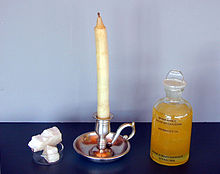This week we will be discussing the candela.

The candela is the SI unit of luminous intensity, the power emitted by a light source in a certain direction. It is closely related to an SI derived unit, the lumen (lm), which measures brightness in all directions. 12.56 lumen is one candela times one steradian. The steradian, in turn, is a dimensionless unit of three dimensional angle (the 12.56 comes from the number of steradians in a sphere, 4𝜋). It specifies the direction of measurement for the candela. All this is to say that a candela works in one direction, while the lumen works in all directions, but they are related. This will come in handy when talking about the candela’s modern definition.
The earliest systematic attempts to define the brightness of light date to the 1700’s with standard candles. These candles were made in specific ways in an attempt to generate a constant light source. Many countries had their own standard candles, like the British candle made from an ounce of spermaceti (Fig 1) burning at a constant rate. However, many factors affect the burning of a candle, and even with the purest materials, the flickering nature of candle flame put paid to this idea.
In 1879, Jules Violle, a French scientist attempted to use freezing platinum as a standard for brightness. Platinum freezes at 1770 C, and, due to the blackbody effect, emits light. Instrumental limitations of the time made this method impractical though.

Then, in 1909 the invention of electric lighting (Fig 2) held promise for a “standard candle” made from a carbon filament bulb, but this too was soon found to be unstable. In 1933, scientists again began courting a platinum-related definition, and in 1948, the blackbody definition was approved. This definition defined light in terms of radiation emitted from a perfect blackbody at the freezing/melting point of platinum. However, a perfect blackbody is only theoretical, rendering this definition mainly mathematical rather than practical.
Finally, in 1979, scientists arrived at what is essentially the modern definition.
“The candela, symbol cd, is the SI unit of luminous intensity in a given direction. It is defined by taking the fixed numerical value of the luminous efficacy of monochromatic radiation of frequency 540 x 1012 Hz, Kcd, to be 683 when expressed in the unit lm W^(-1), which is equal to cd sr W^(-1), or cd sr kg^(-1) m^(-2) s^3, where the kilogram, meter and second are defined in terms of h, c and ΔνCs.”
What this is basically saying is this:
Let’s choose a certain frequency of light, 540 x 1012 Hz (happens to be greenish). Then we define this frequency’s luminous efficacy as 683 lm/W. This 683 number (chosen to match today’s candela to old standard candles) tells us how good the average human eye is at registering this light. The lumen is related to the candela (discussed above) and there you go.
The interesting thing about the candela is that it is specifically related to humans. If aliens came to Earth, we could teach them how long a second is by showing them cesium, but we could not teach them the candela. The magic 683 number is solely based on the human experience which is unrelatable to any other species.
That’s it for the candela. Hopefully my explanation made some sense. The candela has always been the most confusing in my opinion. In my next blog, I’ll talk about the mole (probably), so stay tuned.
This was an incredibly interesting topic. I never knew that such a measurement existed. Your comment reminded me about another similar story. That, if we destroyed all scientific knowledge, we would end up rediscovering the same constants and relationships in nature. But there is no way to guarantee that we would end up at this same measurement of what a candela is. It’s so interesting that most of the other SI units, while arbitrary, can be quantified with things in nature. The candela, and its 638 number would be impossible for us to reproduce. Overall, a very interesting facet of science that I never knew existed!
Thus far, I had been able to recognize the units of measurements you wrote about since I used them frequently for numerous tasks. This was the first one I had never heard of and I found your post rather interesting! This seems complex, as I am not the best when it comes to math and science things. I am still amazed that you know so much about this! Again, I would love to learn how you discovered this topic and it became a passion of yours!
I first developed an interest in metrology when my 9th grade science teacher told me about the unit slug. Its a coherent mass unit in the US Customary System. I’ll have more on it in a future blog.
Another great post! This one was definitely brand new since I have never heard of a candela. It seems very complex so I am glad you have a blog dedicated to explaining it an easier way. I do wonder how often the candela is used today? Are there any modern uses?
Usually, the only people you will hear using the cd are lighting experts such as photographers or designers. Even then, the lumen is usually used instead of the candela. You can see these units if you look on the boxes of lights at Lowe’s though.
I have not experience using the cd in any of my educational career, so I had no idea it even existed! I knew what lumens were only because I wanted a brighter light for my room. For me, light has always been that strange science thing that I’ve accepted and haven’t really gotten into. Hopefully I can apply this knowledge I now have in my future, but if not, it may come up in trivia 🙂